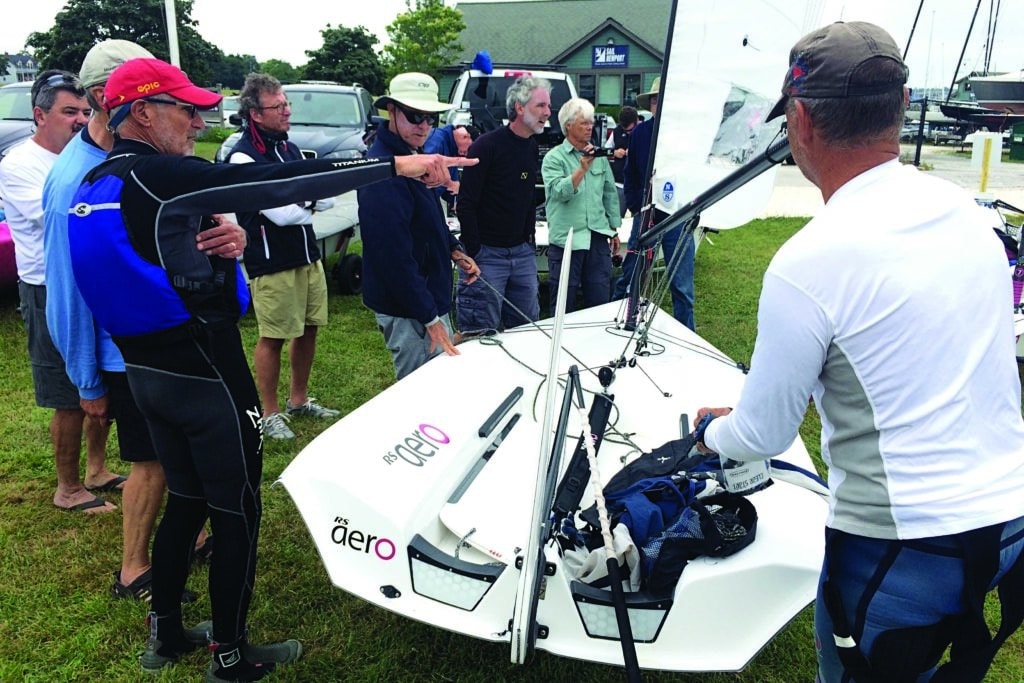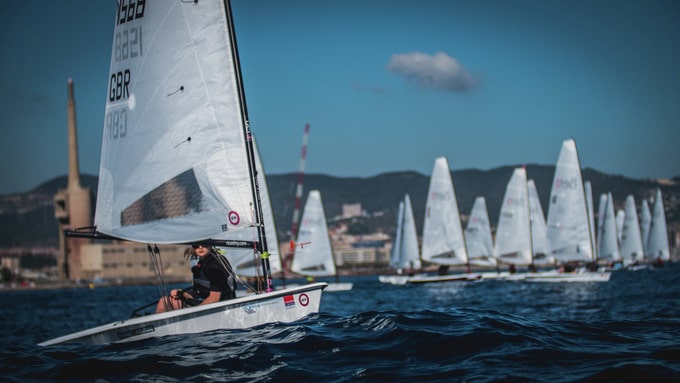
We’re sitting on the grass, a dozen or so middle-aged sailors encircling Marc Jacobi, a four-time Laser Olympic campaigner, whose role today is a combination of New Age sage, counselor and promoter. At his back are the double-axle wheels of a box trailer wrapped in flashy images of a dinghy sailor veiled in spray. Before Jacobi are 17 white Aero dinghies, nestled in dollies. We, a ragtag bunch of mainly Laser converts, have convened for the first official RS Aero sailing clinic in Rhode Island.
Jacobi addresses the unfamiliar group by first inviting each of us to offer a brief personal background. It feels like a therapy session. There’s Derek, a devout Laser sailor from Rhode Island and a prolific blogger of the Laser lifestyle. He ordered his Aero in May 2015, and as far as he knows, he placed the first official North American order. The Aeros of Gary and Eric, each from Massachusetts, came in the same container from England as Derek’s. There’s Tom, who convinced seven of his buddies to buy and start an Aero fleet in Palm Beach, Florida, over the winter. “We’re all still newbies,” he confesses, “but we’re having a lot of fun.”
Melissa and her husband, David, are from Manhattan. The Aero was Melissa’s birthday present, and she can sail it with the smaller, 5-square-meter sail. David can use the 7-square-meter. “I had barely learned to sail Lasers,” Melissa says with a sheepish grin, “and oh my gosh, I now know it doesn’t have to be like that. I love my Aero — that is, when my husband lets me sail it.”
By that, of course, she is alluding to sailing a Laser in Brooklyn.
There’s Greg, a youthful and extremely fit septuagenarian lawyer from Florida. He’s been hauling his Aero up and down the East Coast strapped to a custom rack over the hood of his pickup truck, which pulls his RV, laden with other water toys. Greg came from big boats and got into dinghies late in life. In his search for a boat he could “rack” alone, a friend turned his attention to the Aero.
“What hooked me right away was that the boat is lightweight (78 pounds, says the builder), so I could get it on top by myself. Once I sailed one, I was hooked,” he says.
Greg is now an Aero evangelical of sorts, proudly showing off his boat with the big 9-meter rig on lakes wherever he parks the RV. It’s what keeps him young, he says.
Judith, a regional Laser-class district secretary, is chartering a boat for this weekend’s regatta, but because of her known role supporting the “other” boat, she says jokingly that she’s sailing with the alias “Tammy” for fear of retribution from her Laser peers. She sailed an Aero a month earlier and “basically fell in love with it.”
“If the Laser were reincarnated,” she says, “it would come back as an Aero.”
The petite Simeon Thomas, from landlocked south central Colorado, explains that he has sailed on and off over the past few decades, but only over the last 10 years has he enjoyed the “feeling of the tiller and the hiking strap of a small singlehander.” Getting better has become his obsession. “It’s my number one bucket-list priority,” he says. “I’ve also decided not to sail on Colorado lakes anymore. I want to sail on the open ocean.” And finally, there’s Doug, from California and Utah. He’s a self-proclaimed road warrior and a Laser convert. He loves his Aero very much — so much so, he’ll sail it alone for hours.

I’m chartering a boat for the Sail Newport Regatta to experience it in a full range of conditions over four days. Sailing World’s Boat of the Year judges selected it as the Best Dinghy in 2015. I’ve been eager to race one ever since.
Jacobi, sporting dark sunglasses and his signature wide-brimmed floppy hat, is the RS Aero North American manager. His goal, he announces, is to promote the heck out of it. “You guys are the early adopters,” he says with sincere praise. “It takes guts to do what you did, to buy boats with no assurances that there’d be a fleet, or anything else, for that matter. You bought them because you believe in them.”
Jacobi bought his after reading one of Derek’s blog posts.
“I remember thinking: ‘Whatever. It’s just another boat that’s trying to be the next Laser, and blah, blah, blah,’” he says. “But all of us who’ve sailed the boat now know how fabulous they are. It is a magnificent boat.”
He’s right. Over the course of the regatta, I sailed in 20 knots and 5 knots, pegging 12.1 knots on a reaching contest and enjoying every minute of it. OK, maybe not the senseless drifters, but hey, that’s racing.
Every year after our Boat of the Year Awards, countless complaints come across my screen bemoaning our promotion of new boats that allegedly undermine existing one-design classes, clutter a fractured boat market, and dilute a struggling dinghy-sailing scene in the United States. While these critiques may ring true in insolated cases, it is shortsighted to dismiss a new one-design class outright, especially one that’s more modern, efficient, and even more fun to sail. There’s nothing wrong with a “fun first, fleet second” attitude, because a boat should be enticing to sail, even if you have to race alone or with handicap fleets while the class hopefully catches on.
The Aero is a worthy example. Those who sail it say it is better than a Laser. Comparisons between the boats tend to be about length, weight, etc., but its overall performance and ease of use are more important. Yes, the Laser is the greatest singlehander to this day, but — with apologies to my dear friend and its designer, Bruce Kirby — it’s a new day.
While the Laser is an enduring and sport-changing design, with robust fleets around the world, it’s still stuck in the past. Even with its vastly improved full-rig sail, the mast itself remains outdated. The Aero and the Laser are comparable in price, but the Laser’s builder, LaserPerformance, has disheartened once-loyal sailors and dealers to a point of no return. North American production was quietly shuttered over the past year; boats, basic parts and service are difficult to come by these days.
This void left by LaserPerformance in the United States is an opportunity for Melges (with its new 14-footer) and RS, which has headquarters in England. It’s also a window for Jacobi and his early adopters to spread the word loud and fast. The boat has many selling points: It’s roughly half the weight of a Laser, and the two-piece carbon mast has far better bend characteristics. The sail design and foils are better, the sail controls work, and more importantly, the darn thing is easier and more exciting to sail, especially in stronger winds.
I bought my Laser in 1993, and it now sits on its trailer in my driveway, upside down. It’s given me two decades of unforgettable sailing experiences and friendships, but when I returned home each night after racing the Aero at the Sail Newport Regatta in June, I sort of looked at it with ambivalence.
I don’t have seven grand to spend on a new boat, but I find the Aero’s early adopters inspiring. They saw a better boat and knew the soulful satisfaction it would bring. They sail it for the pure joy of sailing it, with aspirations of flourishing one-design fleets that will someday mirror those of the many local Laser fleets that came before. For the time being, the adopters are preaching, car-topping, and showing off their little lightweight flyers everywhere they go, recruiting or converting one sailor at a time.









